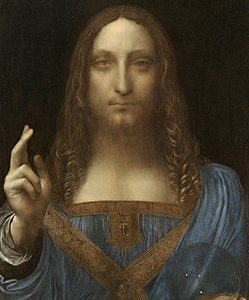The Illicit Art and Antiquities Trafficking Prevention Act, proposed in 2018 by former Republican congressman Luke Messer of Indiana seems to be making a comeback after stalling in Congress. While regulating the art market might seem like a niche topic, increasing transparency and cracking down on the rampant money laundering the art world is increasingly associated with would actually be essential to halting the flow of funds to extremist groups like ISIS and other criminal organizations.
One needs look no further than the highly publicized case of “Salvator Mundi,” supposedly Leonardo da Vinci’s last painting, to understand why the art world needs to be regulated — fast. The artwork’s extraordinary rarity explains the record-setting amount Russian billionaire Dmitry Rybolovlev sold Salvator Mundi for at auction in November 2017. But it also explains why the painting stood at the center of a legal scandal that shook the art world to its very roots.
Indeed, the artwork has exposed a Swiss art dealer as an international fraudster, spawned a bidding war between Arab princes, mysteriously disappeared, and been linked to a wacky conspiracy theory alleging that Israel, Russia, Saudi Arabia and the United Arab Emirates collaborated to get Donald Trump elected. All of this may sound crazy, but in the fast and loose art world it’s simply business as usual.
The painting first emerged from obscurity thanks to New York art dealer Robert Simon, who picked up what he thought was a heavily damaged copy for less than $10,000 in 2005. Once the painting was authenticated as a Leonardo, its value naturally soared — it sold in 2013 for $80 million to a paragon of the art world’s cast of shady characters: Swiss art dealer and billionaire Yves Bouvier, who’s been investigated by U.S. authorities for fraud.
Bouvier is a slippery character whose sobriquet is the “Freeport King” due to his ownership of a vast network of offshore companies and tax-exempt economic free trade zones known as freeports in Switzerland, Luxembourg and Singapore. The Swiss dealer met Rybolovlev in 2002, when the wealthy Russian came to the Geneva Freeport to pick up a Marc Chagall painting. Over the next 12 years, Bouvier sold Rybolovlev 38 paintings, most notably “Salvator Mundi.”
The Leonardo sale sounded the end of their partnership — and the beginning of a continuing legal battle. When Rybolovlev read in a newspaper article that his dealer had bought “Salvator Mundi” for $80 million and then sold it to him for $127.5 million, he began looking into just how significant a markup Bouvier had been making off their transactions. The scale of what he uncovered prompted him to initiate legal proceedingson two continents, trying to recover the $1 billion he allegedly overpaid Bouvier.
Rybolovlev and Bouvier’s international legal wrangling has been a particularly theatrical example of the dirty dealings that often occur in freeports. As a boom in the art market has prompted new freeports to spring up around the world, authorities have sounded the alarm over the shady activities for which the tax-free zones often provide cover. Unscrupulous investors are using freeports as “black holes for dodging taxes,” while — as former congressman Messer pointed out — looted antiquities from Syria or Iraq are ending up in Swiss freeports, their funds eventually channeled to terrorist groups.
The exorbitant price tag of the painting has helped fuel the increasingly unhinged conspiracy theories surrounding the painting. Russiagate blogger Zev Shalev has insistedthat such a high amount must be covering up something fishy and that Rybolovlev put the painting up for sale knowing the Saudis and the Emiratis would bid for it, artificially inflating its value. Shalev also boldly stated that the sale of “Salvator Mundi” has been a subject of special counsel Robert Mueller’s investigation, a claim that has never been backed by any evidence.
Art insiders have also thrown cold water on the theory, suggesting that the “Salvator Mundi” sale was too high-profile to be part of some dastardly scheme. As Artnet critic Ben Davis emphasized, “If you’re going to do something really, really shady, you might not want to do it in a way that’s designed to put a big arrow over your head that says, ‘Look at me! Investigate me!’”
Georgina Adam, another art critic and writer, had a similar reaction: “I thought from the very beginning that it was completely bonkers. Would you launder money in public?”
Though many of the twists and turns of “Salvator Mundi’s” history can be chalked up to similarly banal explanations, they — along with the wild speculation it has engendered — nevertheless reveal how the unregulated art market has become overrun with a motley crew of conmen and conspiracy theorists.
Authorities often have little way of unraveling the tangled webs of trusts, offshore accounts and freeports that individuals like Bouvier dabble in. Even worse, many of these methods are currently completely legal — art has been referred to as “the largest unregulated market in the world,” making it a natural refuge for criminal organizations and tax evaders.
In the United States, Delaware is fast emerging as a choice destination for tax dodgers, with some companies even offering shuttle services between the First State’s freeports and New York.
For years, U.S. officials have been powerless to clamp down on this gray market; The Illicit Art and Antiquities Trafficking Prevention Act would provide them with a valuable tool to root out the miscreants, making their fortunes through untaxed Picassos and looted Syrian treasures.

